IFUGAO TRIBE:
TRIBAL USED AUTHENTIC ANTIQUE
STANDING BULUL STATUE PAIR.
|
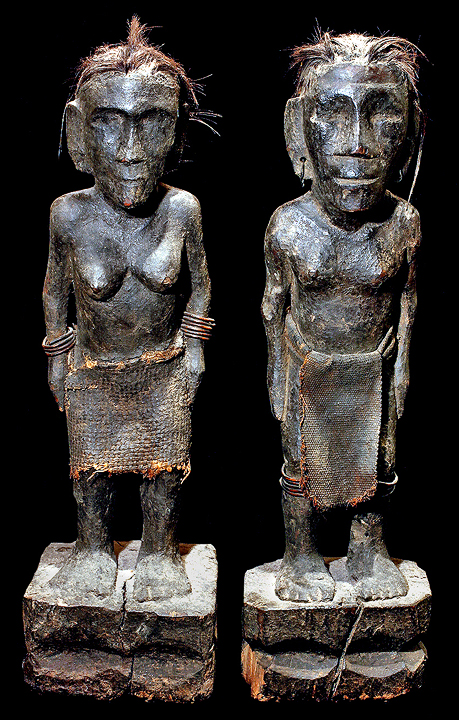
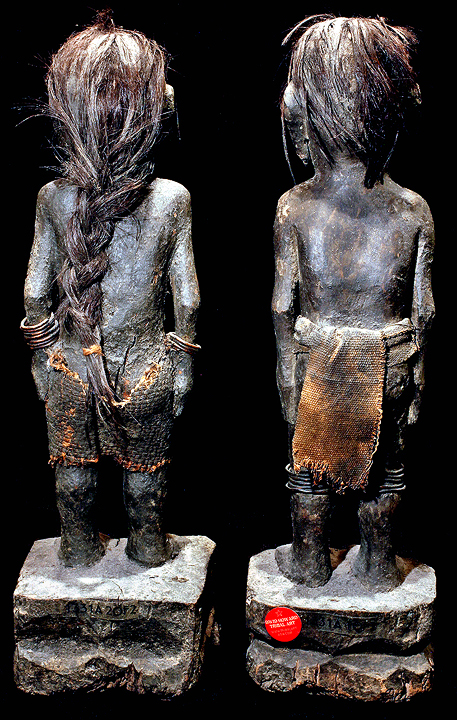
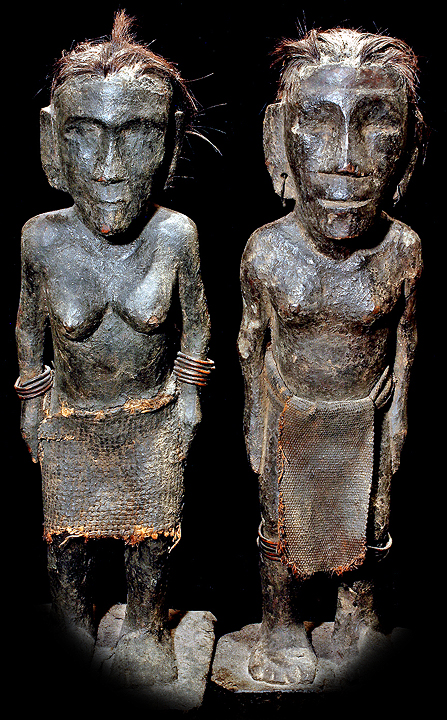
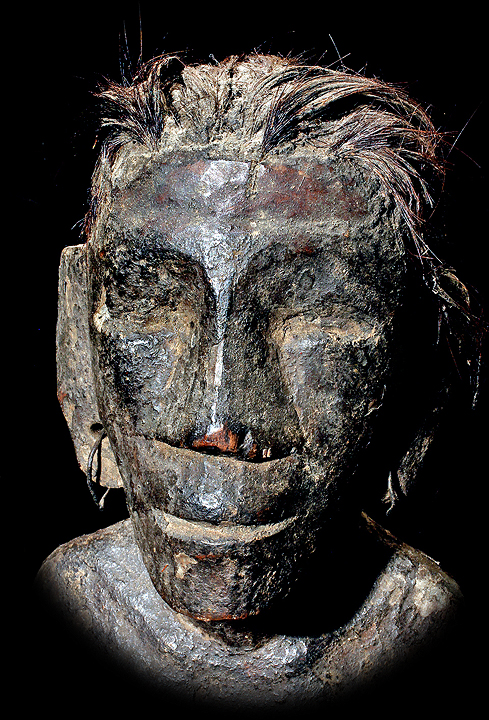
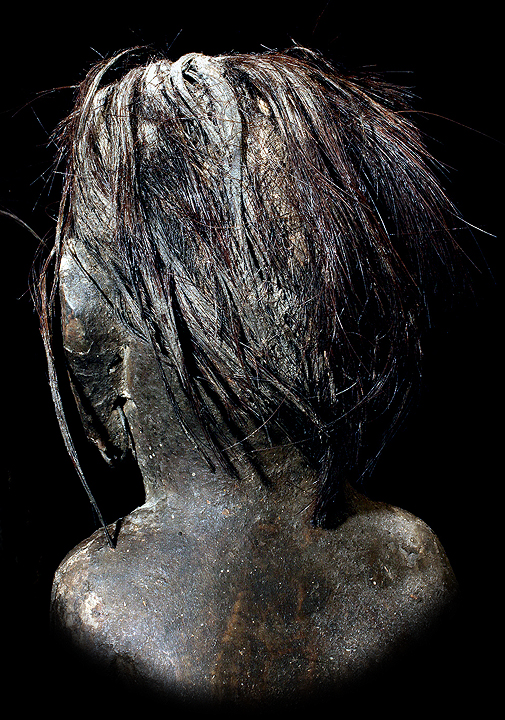
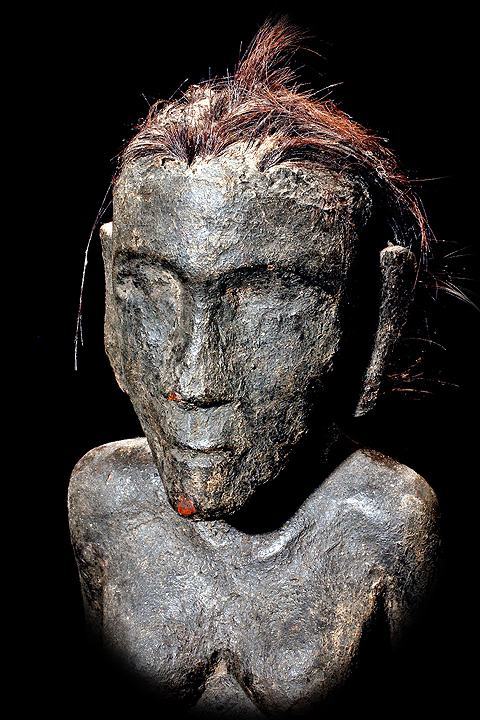
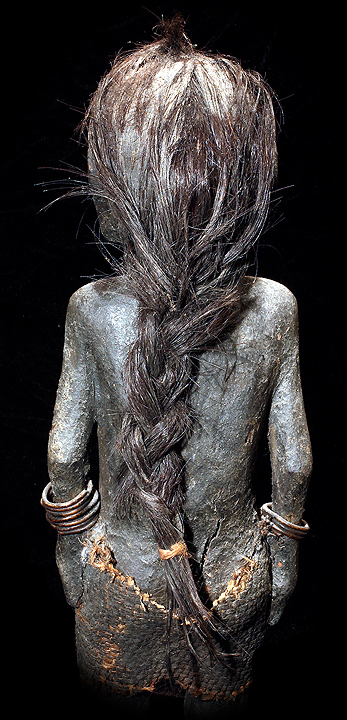
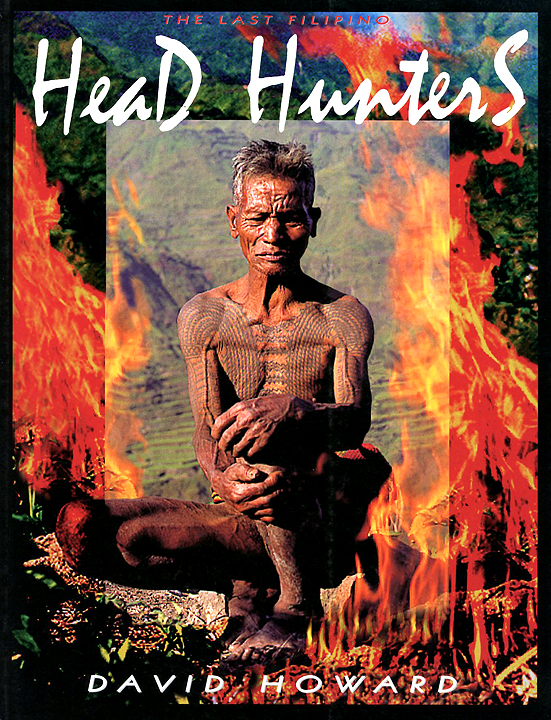
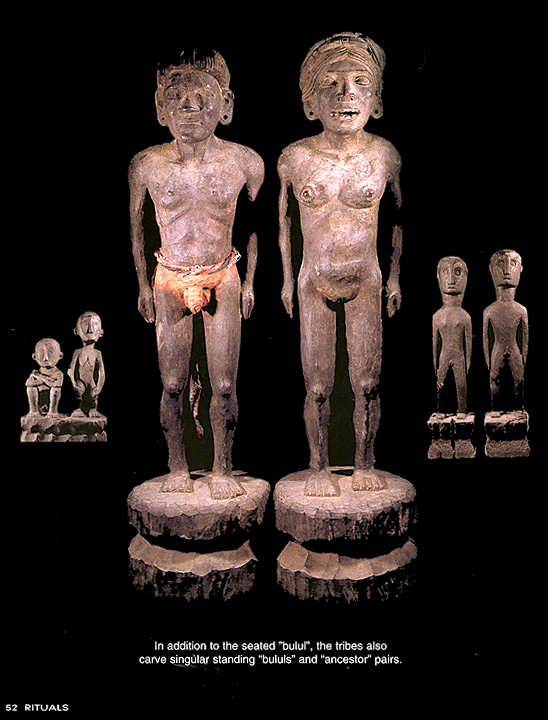
 IFUGAO TRIBE:
IFUGAO TRIBE:
TRIBAL USED AUTHENTIC
ANTIQUE STANDING BULUL STATUE PAIR;
HAND CARVED WOOD
EACH STATUE: 17 X 5 X 3 INCHES
NO REPAIRS, RESTORATION, OR MISSING PIECES.
THERE IS A COLLECTION CATALOGUE NUMBER
ON THE BACK THAT READS: “1331A” AND A RED
CIRCULAR “DAVID HOWARD TRIBAL ART”
STICKER. THESE RARE AND UNUSUAL PIECES
HAVE A FINE, RICH, DARK, PATINA; EVIDENCE
OF USE IN MANY IFUGAO HARVEST RITUALS.
THESE PIECES SHOW WEAR AND SIGNS OF TRIBAL
USE. THE MALE FEATURES METEL EARRINGS, A
WOVEN TEXTILE AROUND THE WAIST AND METEL
ANKLE BRACELETS. THE FEMALE HAS METEL
WRIST BRACELETS, A HAND WOVEN
FIBER TAPIS DRESS AND A BRAID.
FOR SIMILAR EXAMPLES REFERENCE
PAGE #52 IN
THE BOOK ENTITLED: “THE LAST FILIPINO HEAD HUNTERS.”
A
Bulul is a carved wooden figure
used to guard the rice crop by the tribes people in northern Luzon
Island.
The sculptures are highly stylized representations of ancestors, and
are thought to gain power from the presence of the ancestral spirit.
The Ifugao are particularly noted for their skill in carving bululs.
Bululs are used in ceremonies associated with rice production and with
healing. Creation of a bulul involves alwen bulol ritual by a priest to
ensure that the statue gains power. The bulul is treated with care and
respect to avoid the risk of the spirits of the ancestors bringing
sickness. The figures are placed in rice granaries to bring a plentiful
harvest. A large granary may need two bululs, and a wealthy noble may
also have one or more bululs in his house. Male and female Bulul
statues are often found together, with sex-related symbols such as the
mortar for the female and pestle for the male. A male bulul may
sometimes be decorated with a g-string, and a female with a waist
cloth, earrings and anklets. Although the form varies, the bulul is
commonly represented as seated on the ground, with arms crossed over
his upraised knees. The bulul has a simplified form, and is
traditionally carved from narra or ipil wood or sometimes stone. The
bulul is touched by hands dipped in blood of a chicken or pig in ritual
called tunod during the rice planting season. Over time the blood
imparts a dark color to the figures, overlaid with a patina of grease
from food offerings. Bululs are handed down to the first child of a
family. Typically the older statues have beetle holes made by insects
in the granary.
Ifugao
culture revolves around rice, which is considered a prestige
crop. There is an elaborate and complex array of rice culture feasts
inextricably linked with taboos and intricate agricultural rites, from
rice cultivation to rice consumption. Harvest season calls for
grandiose thanksgiving feasts, while the concluding harvest rites
"tungo" or "tungul" (the day of rest) entail a strict taboo of any
agricultural work. Partaking of the rice wine (bayah), rice cakes, and
'moma' (mixture of several herbs, powdered snail shell and betel nut/
arecoline: and acts as a chewing gum to the Ifugaos) is an indelible
practice during the festivities and ritual activitiess. their retual
and Agricultural terracing is their principal means of livelihood along
with farming. Their social status is measured by the number of rice
field granaries, family heirlooms, gold earrings, carabaos (water
buffaloes), as well as, prestige conferred through time and tradition.
The more affluent, known as kadangyan were usually generous by nature,
giving rice to poor neighbors in time of food shortage(s) and/or
hardship(s). Furthermore, their culture was known for their legal
system, using one of the world's most extensive oral legal traditions
specifying the offense depending on the use of custom law; trial by
elders (influenced in part by public opinion); or trial by ordeal. The
wealthy were subjected to greater fines than the poor.
The
Ifugao art of woodcarving is
universally known. Most notably are the carved granary guardians
“bulul,” and the prestige bench; the “hagab,” but in addition to those
free standing wood carvings: The Ifugao also incorporate beautiful
architectural wood cavings into their hut’s house posts, exterior
doors, kitchen shelving and a multitude of imaginative additions to
nearly every element in, and on, their Ifugao huts!
Ifugao huts are well-constructed and
characterized by wooden floors, windowless walls, and pyramidal thatch
roofs. Elevated from the ground by four sturdy tree trunks, they
feature removable staircases that are hoisted up at night to prevent
entry by enemies or wild animals.
There are many varieties of Ifugao
huts. They have heavy thatch roofs to serve as protection from rain and
cold weather. The Ifugao inhabit the rugged terrain of the Cordillera
Mountain Range in the Mountain Province of Central Northern Luzon
Island. They have developed and maintained a distinct culture which
resisted outside influence. Modern times ended their isolation; The
only world they previously knew was an environment of towering
mountains, rolling hills, windy plateaus, warm valleys, shallow but
swift rivers, dense forests, rice paddies, and their immense
rice
terraces
known as “The 7th Wonder of the World!”
"PUNAM-HAN"
are
used in sacrificial offertory rituals by Ifugao Mombaki Shamans; the
blood of butchered animals are poured over
the outside while rice in combination with wrapped textile bundles,
small wooden carvings; "Hipag" figures, wrapped bamboo, animal
sacrificial implements and any assortment of appropriate tribal
sacrificial elements are placed inside as offering to the Ifugao
gods. The Punamhan is regarded as a sacred tribal ritual object by the
Ifugao tribe.
Untouched
by the influences of Spanish colonialism, Ifugao culture
value kinship, family ties, religious and cultural beliefs. They're
unique among all ethnic groups in the mountain province, not only for
their interesting customs and traditions but also for their narrative
literature such as the hudhud, an epic dealing with hero ancestors sung
in a poetic manner. Another feature unique to the Ifugao is their
woodcarving art, most notably the carved granary guardians bului and
the prestige bench of the upper class, the hagabi. Their textiles
renowned for their sheer beauty, colorful blankets and clothing woven
on looms. Houses were well-built, characterized by as a square with
wooden floors, windowless walls, and pyramidal thatch roofs. Elevated
from the ground by four sturdy tree trunks, they feature removable
staircases that were hoisted up at night to prevent entry by enemies
and/or wild animals. Lastly, their attire remain traditional for male
Ifugaos, donning the wanno or g-string; there are six types of wanno
which are used depending on the occasion or the man's social status.
Ifugao women, on the contrary, wear tapis, a wraparound skirt; there
are five kinds of skirts worn, depending on the occasion.
A Kankanaey
"Anito" represents ancestor spirits, nature spirits, and deities in the
indigenous animistic religions of pre colonial Philippines. They can
also be referred to as Tinagtaggu or Taotao; carved humanoid figures
that represent ancestral spirits.
Two
famous institutions of the Kankanaey; who inhabit the Mountain
Province, on Luzon Island, in the Philippines, are the
"Dap-ay;" the men's dormitory and civic center, and the "Ebgan;" the
girls'
dormitory where courtship between young men and women takes place. The
Bontoc tribe in Sagada, and some nearby pueblos; Takong and Agawa,
the "O-lâg" is the name of the girl's dormitory and
the boy's dormitory is
referred to as; "F-gan."
The Kankanaey differ in the way they dress. Not all Kankanaey exhibit
the same tribal colors or clothing styles. The "soft-speaking"
Kankanaey woman's "Tapis" dress has a color combination of black, white
and red. The
design of the upper attire is a criss-crossed style of black, white,
and
red colors. The skirt, or tapis, is a combination of stripes of black,
white and red.
The "hard-speaking" Kankanaey woman's dress, referred to as a "Tapis;"
is composed mainly of red and
black with a little white color, and is generally referred to a
"Bakget" or a "Gateng." The men ware a "G-string" which is referred to
as a "Wanes" by the Kanakaneys of Besao and
Sagada. The design of the Wanes G-string may vary according to social
status or
municipality.
The Kankanaey's major dances include tayaw, pattong,as Igorot wedding
dance, and balangbang. The tayaw is a community dance that is usually
done in weddings; it may be also danced by the Ibaloi people but has a
different style. Pattong is also a community dance from Mountain
Province which every municipality has its own style. Balangbang is the
modernized word for the word Pattong. There are also some other dances
that the Kankanaeys dance, such as the sakkuting, pinanyuan (wedding
dance) and bogi-bogi (courtship dance). Kankanaey houses are built like
the other Igorot houses, which reflect their social status.
THE IFUGAO
TRIBE, ON THE ISLAND: LUZON
IN THE PHILIPPINES, USE
"PUNAMHAN"
HAND CARVED WOODEN BOXES
THAT ARE
"ACTIVATED" THROUGH RITUAL
ANIMAL
BLOOD SACRIFICE.
THE IFUGAO; ORIGINALLY REFERRED TO AS "IGOROTS" WERE
ONCE THOUGHT TO BE INCLUDED WITH THE BONTOC, KALINGA
KANKANAY, IBALOI AND GADDANG AS A SINGLE TRIBE!
IT WAS NOT UNTIL EXHAUSTIVE RESEARCH LATER REVEALED
THESE WERE INDIVIDUAL TRIBES WITH DISTINCT
CULTURAL DIFFERENCES AND BELIEF SYSTEMS!
|
David Howard Tribal Art Tribal Art Asia
DAVID HOWARD AUTHORED BOOKS: "THE LAST FILIPINO HEAD HUNTERS," "SACRED
JOURNEY: THE GANGES TO THE HIMALAYAS," "TEN SOUTHEAST ASIAN TRIBES FROM
FIVE COUNTRIES" AND "PERSPECTIVES: INTERVIEWS ANSEL ADAMS, JERRY
UELSMANN, RALPH GIBSON, AND ROBERT HEINECKEN." COVER "SMITHSONIAN
MAGAZINE" 2014, DVD DOCUMENTARIES: "CHRISTO: THE UMBRELLA PROJECT,"
"KEITH HARING: ARTIST AT WORK" AND "NAM JUNE PAIK." DAVID HOWARD'S
MUSEUM COLLECTIONS: THE METROPOLITAN MUSEUM OF ART; NEW YORK 2011, THE
FIELD MUSEUM; CHICAGO 2013, THE MUSEUM OF MODERN ART (S.C.75.123); NEW
YORK 1975, THE MUSEUM OF MODERN ART; SAN FRANCISCO: (SAN FRANCISCO ART
INSTITUTE PHOTOGRAPHY PORTFOLIO) 1975, THE WHITNEY MUSEUM OF AMERICAN
ART; (EAST VILLAGE ART SCENE DOCUMENTARY), NEW YORK 1985, THE OAKLAND
MUSEUM; OAKLAND CALIFORNIA 1973. CLIENTS INCLUDE: PACE PRIMITIVE N.Y.C.
THAMES & HUDSON, SMITHSONIAN MAGAZINE, THOMAS MURRAY: ASIATICA,
ALEX ARTHUR; “TRIBAL MAGAZINE,” MARK JOHNSON TRIBAL ART, SUTTERFIELD
TRIBAL ART, DAVE DEROCHE: GALLERY DEROCHE, ERIK FARROW: FARROW FINE
ART, JOE GERENA FINE ART N.Y.C., STATE FARM INSURANCE COMPANY APPRAISAL
CONSULTANT, P.B.S., B.B.C., BILL JAMESON, TASCHEN, XANADUE GALLERY,
TONY MILTON: GONE BEYOND, RIPLEYS BELIEVE IT OR NOT MUSEUM, RUDOLF
KRATOCHWILL: MABINI PROJECTS.
Asian tribal art, artifacts, ifugao, kalinga, bontoc,
asmat, dayak, philippines, asia, head hunters, human trophy skull,
skulls, african, antiques, naga, necklace, headdress, head hunting
trophy skull, Indonesia, Indonesian, SOUTHEAST ASIA, Borneo, Sarawak,
ANTIQUES, Kalimantan, Sulawesi, ART, Sumatra, Timor, ARTIFACTS, Bali,
Java, INDIA, Flores, Sumba, NEPAL, Savu, Roti, BABAS, Lombok, Malaysia.
HOLY MEN, Nusa Tengara, New Guinea, SHAMAN, Irian Jaya, Moluccas,
CONTEMPORARY ART, Tanimbar, Leti, OLD, Lembata, Alor, MINILA,
Philippines, Luzon, PALAWAN, Mindanao, Sulu, BLOW GUN, Southeast Asia,
Asia, NOSE RING, Asian, Burma,
HAT, Myanmar, India, SWORD, Nagaland, Nepal, KNIFE, Tibet, Himalaya,
MOUNTAIN, Himalayan, Assam, TRIBES, Thailand, Vietnam, YAO, Yunnan,
Hainan, HMONG, China, Central Asia, ZAO, Dayak, Batak, BAG, Toraja,
Naga, POLE, Chin, Li, QUIVER, Miao, Bahau, MASK, Punan, Penan, MODELED
SKULL,
Modang, Kayan, BRASS COIL, Kenyah, Ngaju, COILS, Kontu, Kantu, TEXTILE,
Iban, Maloh, PRIEST, Tunjung, Busang, RITUAL, Aoheng, Dong Son,
MYSTICAL
Konyak, Tangkhul, MYSTIC, Ao, Angami, PRIMITIVE, Sema, Wancho,
HAND MADE, Bontoc, B'laan, ARTIST, Bagabo, Gaddang, BULUL, Ifugao.
Sculpture, BULULS, statue, mask, BOX, beadwork, bead, AUTHENTIC,
textile,
weaving, TRIBAL, costume, hat, WOODEN, shield, spear, WOOD, helmet,
sword, BOAR, charm, fetish, FEATHERS, drum, basket, FEATHER, basketry,
jewelry, SILVER, ornament, weapon, ASMAT Canoe, amulet, decoration,
SCULPTURAL,
architecture, architectural, SCULPTURE, longhouse, headhunter, SKULL,
headhunting, shaman, TRIBAL, festival, ceremony, ceremonial, SHAMAN
ritual, tattoo, HEAD HUNTER Skull, dragon, hornbill, HEADDRES, art,
tribal,
VIETNAM, tribe, culture, TRIBES, cultural, myth, TRIBAL, artifact,
artefact, REAL, wood, stone, HAND WOVEN, cotton, metal, CAST bronze,
brass,
cloth, ISLAND, tropics, tropical, EQUATOR, ethnographic, EQUATORIAL,
Tribal Art, Primitive Art, Ethnographic Art, Oceanic Art, Folk Art,
Ethnic Cultures, AUTHENTIC Artifacts, Textiles, ANCIENT, Costumes,
Sculpture, SCULPTURES, Masks, Beadwork, BEADS, Fetishes, Charms, GOLD
Jewelry, Baskets, BAMBOO, Weapons, Shields, ORNATE, Indonesia, Borneo,
PUPPETS,
Sumatra, Sulawese, SHADOW PUPPET, Java, Bali, CAVE, Timor, Flores,
ISLAND, Sumba. Lombok, VILLAGE, Molucca, Philippines, RICE TERRACE,
Luzon,
Mindanao, DAVID HOWARD PHOTOGRAPHY, Nepal, Burma, SACRED JOURNEY:
THE GANGES TO THE HIMALAYAS, Thailand, THE LAST FILIPINO HEAD HUNTERS,
Laos,
Vietnam, TEN SOUTHEAST ASIAN TRIBES FROM FIVE COUNTRIES, India, Central
Asia,
NECKLACES, Southeast Asia, Dayak, STATUE, lban, Kayan, INK STAMP,
Kenyah, Modang, FEATHERED, Bahau, Ngaju, HORSE, Batak, Toraja,
NAGALAND,
Naga, Dong Song. TRIBAL ART, AUTHENTIC PRIMITIVE ART, OLD ETHNOGRAPHIC
ART, RARE OCEANIC ART, BEAUTIFUL FOLK ART, ETHNIC CULTURES,
TRIBAL
ARTIFACTS, TEXTILES, ASIAN, COSTUMES, SCULPTURE, WOOD MASKS, BEADWORK,
CHARMS,
FETISHES, SIVER JEWELRY BOXES, BASKETS, WEAPONS, FILIPINO SHIELDS,
INDONESIA, BORNEO, ETHNOGRAPHIC, SUMATRA, SULAWESE, TRIBAL, JAVA,
BALI, TRIBES, TIMOR, FLORES, ASIAN, SUMBA. LOMBOK, TRIBES, MOLUCCA,
PHILIPPINES, TRIBAL, LUZON, ASIAN, MINDANAO, NEPAL, ASIA, BURMA,
THAILAND, TRIBAL,
LAOS, VIETNAM, TRIBES, INDIA, CENTRAL TRIBAL ASIA, ARTIFACTS, SOUTHEAST
ASIA, HEAD HUNTER, DAYAK, ASIAN, IBAN, KAYAN, TRIBE, KENYAH, MODANG,
TRIBAL,
BAHAU, NGAJU, ASIAN, BATAK, TORAJA, TRIBE, NAGA, tribal art, ASIAN,
primitive art, ASIA, ethnographic art, TRIBAL, oceanic art, ASIAN
folk art, SOUTHEAST ASIA ethnic cultures, artifacts, ASIAN, textiles,
costumes,
VILLAGE sculpture, masks, TRIBAL beadwork, fetishes, TRIBES charms.
jewelry, TRIBE, baskets, weapons, TRIBAL, shields, indonesia, ASIAN,
borneo. sumatra, TRIBAL ART sulawese, java, HILL TRIBE, bali, timor,
ASIAN,
flores, sumba, TRIBES, lombok, molucca, BULUL STATUES philippines,
luzon, ISLAND ART, mindanao, nepal, ASIA, burma, thailand, JOURNEY
laos, vietnam, TRIBAL, india, central asia, TRIBE, southeast asia, OLD
ART, dayak. lban, TRIBES, kayan, kenyah, ASIAN, modang, bahau,
AUTHENTIC
TRIBAL ART, ngaju, batak, HEADDRESS, toraja, naga, MOUNTAIN PROVINCE,
dong
song, KALINGA, Indonesia, Indonesian, IFUGAO, Borneo, Sarawak,
BONTOC, Kalimantan, Sulawesi, TRIBAL, Sumatra, Timor, ASIAN, Bali,
Java, OLD TRIBAL ART
Flores, Sumba, Savu,
Roti, Lombok, Malaysia. Nusa Tengara, New Guinea, Irian Jaya, Moluccas,
Tanimbar, Leti, Lembata, Alor, Philippines,
Luzon, Mindanao, Sulu, Southeast Asia, Asia, Asian, Burma. Myanmar,
India, Nagaland, Nepal, Tibet, Himalaya, Himalayan, Assam, Thailand,
Vietnam, Yunnan, Hainan, China, Central Asia, Dayak, Batak, Toraja,
Naga, Chin, Li, Miao, Bahau, Punan, Penan, Modang, Kayan. Kenyah,
Ngaju, Kontu, Kantu, Iban, Maloh, Tunjung, Busang, Aoheng, Dong Son,
Konyak, Tangkhul, Ao, Angami, Sema, Wancho, Bontoc, B'laan, Bagabo,
Gaddang, Ifugao. Sculpture, statue, mask, beadwork, bead, textile,
weaving, costume, hat, shield, spear, helmet, sword, charm, fetish,
drum, basket, basketry, jewelry, ornament, weapon. Canoe, amulet,
decoration, architecture, architectural, longhouse, headhunter,
headhunting,
shaman, festival, ceremony, ceremonial, ritual, tattoo. Skull, dragon,
hornbill, art, tribal, tribe, culture, cultural, myth, artifact,
artefact, wood, stone, cotton, metal, bronze, brass, cloth, tropics,
tropical, ethnographic,
primitive, art, masks, asian, ethnographic, oceanic, folk, ethnic
cultures,
artifacts, Bahau, Kalimantan, indonesia, borneo, sumatra. sulawese,
java, bali, timor. flores, sumba, lombok, molucca, philippines, luzon,
mindanao, nepal, burma, thailand, laos, vietnam, india, central asia,
southeast. dayak, lban, kayan, kenyah, modang, bahau, ngaju, batak.
toraja, naga, dong song. Myanmar, Burma, Kachin, Naga, Konyak, Chin,
Ao, Wancho, Thangkul, Dao, Helmet, Hat, Hornbill, Mizo, Sema, Assam,
India, Mithan, Maram, Morung, Myth, Dream, Post, Pillar, Panel,
Architecture,
Architectural, Tusk, Hill Tribe, Sacrifice, Skull, War Path, Ritual.
Spirit, Figure, Motif, Design, Ceremony, Ceremonial, Raid, Fur, Claws,
Teeth, Fangs, Carving, Statue, Sculpture, Kalinga, Ifugao, Luzon,
Mindanao, T'boli, Bagabo, B'laan, Sulu, Philippines, Weaving, Blouse,
Skirt, Sarong, Shawl, Necklace, Bracelet, Conch Shell, Shell, Brass,
Spear.
Feather, House, Tradition, Traditional, Ancestor, Cloth, Ikat, Chapan,
Uzbek, Asia, Turkoman, Turkamen, Dragon, Snake, Bird, Gong, Island,
Indonesia, Indonesian, Borneo, Sarawak, Kalimantan, Sulawesi, Sumatra,
Timor, Bali, Java, Flores, Sumba, Savu, Roti, Lombok, Malaysia. Nusa
Tengara, New Guinea, Irian Jaya, Moluccas, Tanimbar, Leti, Lembata,
Alor, Philippines, Luzon, Mindanao, Sulu, Southeast Asia, Asia, Asian,
Burma. Myanmar, India, Nagaland, Nepal, Tibet, Himalaya, Himalayan,
Assam, Thailand, Vietnam, Yunnan, Hainan, China, Central Asia, Dayak,
Batak, Toraja, Naga, Chin, Li, Miao, Bahau, Punan, Penan, Modang,
Kayan.
Kenyah, Ngaju, Kontu, Kantu, Iban, Maloh, Tunjung, Busang, Aoheng,
Dong Son, Konyak, Tangkhul, Ao, Angami, Sema, Wancho, Bontoc, B'laan,
Bagabo, Gaddang, Ifugao. Sculpture, statue, mask, beadwork, bead,
textile, weaving, costume, hat, shield, spear, helmet, sword, charm,
fetish, drum, basket, basketry, jewelry, ornament, weapon. Canoe,
amulet, decoration, architecture, architectural, longhouse, headhunter,
headhunting, shaman, festival, ceremony, ceremonial, ritual, tattoo.
Skull, dragon, hornbill, art, tribal, tribe, culture, cultural, myth,
artifact, artefact, wood,
stone, Indonesia, Indonesian, Borneo, Sarawak, Kalimantan, Sulawesi,
Sumatra, Timor, Bali, Java, Flores, Sumba, Savu, Roti, Lombok,
Malaysia. Nusa Tengara, New Guinea, Irian Jaya, Moluccas, Tanimbar,
Leti, Lembata, Alor, Philippines, Luzon, Mindanao, Sulu, Southeast
Asia, Asia, Asian, Burma. Myanmar, India, Nagaland, Nepal, Tibet,
Himalaya, Himalayan, Assam, Thailand, Vietnam, Yunnan, Hainan, China,
Central Asia, Dayak, Batak, Toraja, Naga, Chin, Li, Miao, Bahau, Punan,
Penan, Modang, Kayan. Kenyah, Ngaju, Kontu, Kantu, Iban, Maloh,
Tunjung, Busang, Aoheng, Dong Son, Konyak, Tangkhul, Ao, Angami, Sema,
Wancho, Bontoc, B'laan, Bagabo, Gaddang, Ifugao. Sculpture, statue,
mask, beadwork, bead, textile, weaving, costume, hat, shield, spear,
helmet, sword, charm, fetish, drum, basket, basketry, jewelry,
ornament, weapon. Canoe, amulet, decoration, architecture,
architectural, longhouse, headhunter, headhunting, shaman, festival,
ceremony, ceremonial, ritual, tattoo. Skull, dragon, hornbill, art,
tribal,
tribe, culture, cultural, myth, artifact, artefact, wood, stone,
cotton,
metal, bronze, brass, cloth, tropics, tropical, ethnographic.
Japan, Japanese, shrine,
Masks, tsuba, kabuto, mempo, Dayak, Indonesian, sculpture, Indian Cola,
Tibetan
Thanka, Batak. Timor, Nias, African, Oceanic, Philippines, Luzon,
Ifagao,
Batak, Dyak, Nias, Bul'ul, artifacts, authentic, antique, asian, asia,
expert, dealer, sell, buy, Los Angeles, California, JAPAN, JAPANESE.
SHRINE,
MASKS, TSUBA, KABUTO, MEMPO, DAYAK. INDONESIAN, SCULPTURE, INDIAN COLA,
TIBETAN THANKA, BATAK, TIMOR, NIAS, AFRICAN, OCEANIC. PHILIPPINES,
LUZON,
IFAGAO, BATAK, DYAK, NIAS, BUL'UL, ARTIFACTS, AUTHENTIC, ANTIQUE,
ASIAN,
ASIA, EXPERT, DEALER, SELL, BUY, Japan, Japanese, Shrine, Masks, Tsuba,
Kabuto, Mempo, Dayak, Indonesian, Sculpture. Indian Cola, Tibetan
Thanka,
Batak, Timor, Nias, African, Oceanic, Philippines, Luzon, Ifagao,
Batak,
Dyak, Nias, Bul'ul, Artifacts, Authentic, Antique, Asian, Asia, Expert,
Dealer, Sell, Buy, japan, japanese, shrine, masks, tsuba, kabuto,
mempo,
dayak, indonesian, sculpture, indian cola, tibetan thanka, batak,
timor, nias, african, oceanic, philippines, luzon, ifagao, batak, dyak,
nias,
bul'ul, artifacts, authentic, antique, asian, asia
Japan, Japanese, shrine,
Masks, tsuba, kabuto, mempo, Dayak, Indonesian, sculpture, Indian Cola,
Tibetan
Thanka, Batak. Timor, Nias, African, Oceanic, Philippines, Luzon,
Ifagao,
Batak, Dyak, Nias, Bul'ul, artifacts, authentic, antique, asian, asia,
expert, dealer, sell, buy, Los Angeles, California, JAPAN, JAPANESE.
SHRINE,
MASKS, TSUBA, KABUTO, MEMPO, DAYAK. INDONESIAN, SCULPTURE, INDIAN COLA,
TIBETAN THANKA, BATAK, TIMOR, NIAS, AFRICAN, OCEANIC. PHILIPPINES,
LUZON,
IFAGAO, BATAK, DYAK, NIAS, BUL'UL, ARTIFACTS, AUTHENTIC, ANTIQUE,
ASIAN,
ASIA, EXPERT, DEALER, SELL, BUY, Japan, Japanese, Shrine, Masks, Tsuba,
Kabuto, Mempo, Dayak, Indonesian, Sculpture. Indian Cola, Tibetan
Thanka,
Batak, Timor, Nias, African, Oceanic, Philippines, Luzon, Ifagao,
Batak,
Dyak, Nias, Bul'ul, Artifacts, Authentic, Antique, Asian, Asia, Expert,
Dealer, Sell, Buy, japan, japanese, shrine, masks, tsuba, kabuto,
mempo,
dayak, indonesian, sculpture, indian cola, tibetan thanka, batak,
timor, nias, african, oceanic, philippines, luzon, ifagao, batak, dyak,
nias,
bul'ul, artifacts, authentic, antique, asian, asia
David Howard, art, artist, photography, photographic,
photographs,
print, prints, director, producer, exhibitions, exhibits, exhibit,
painting, paint, studio, studios, etching, silkscreens, silkscreen,
contemporary art, Pop Art, artist's story, journal, video, videos,
documentary, documentaries, books, book, asian, asia, Filipino,
Philippines, Sacred Journey, author, The Last Filipino Head Hunters,
collections, collectables, collectable, archives, archive, art, fine,
contemporary, video, dvd, documentary, Keith Haring, Nam June Paik,
Christo, Lowell Nesbitt, Lawrence Ferlinghetti, Charles Arnoldi,
artists, studio visit, artist, program, sculpture, painting,
photography, prints, print,
photo, paintings, sculptures, keith haring, christo, david howard, nam
june
paik, artseen, videos tape, programs, documentaries, arts, world, san
francisco,
new york, los angeles
ANDY WARHOL,
JOSEPH ALBERS, ELLSWORTH KELLY, CLAES
OLDENBURG,
ROBERT MOTHERWELL, FRANK STELLA, JAMES ROSENQUIST, ROBERT RAUSCHENBURG,
KEITH
HARING, CHRISTO, ROBERT INDIANA, ROY LICHTENSTEIN, ROBERT MAPPLETHORPE,
ALICE
NEAL, ARTISTS, ART, ARTIST, PAINTING, SCULPTURE, PHOTOGRAPHY, SITE
SPECIFIC,
NAM JUNE PAIK, KENNY SCHARF, LOWELL NESBITT, LAWRENCE FERLINGHETTI,
ARMAN
ARMAN, CHARLES ARNOLDI, CHRIS BURDEN, ART STUDIOS, VIRTUAL REALITY,
ABSTRACT
EXPRESSIONISM, PRINT MAKING, ETCHING, PAINTING, HOLOGRAPHY, AFRICAN
ART,
WOODCARVING, MURAL. MURALS, COMPUTER ART, FIGURATIVE EXPRESSIONISM,
IMPRESSIONISM,
MULTI-MEDIA, MULTI MEDIA
tribal art, tribal arts, antique tribal
art, fine art, antique traditional art, traditional art, asian tribal
art,
american tribal art, african tribal art, tribal mask

